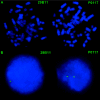Identification of a major recombination hotspot in patients with short stature and SHOX deficiency
- PMID: 15931595
- PMCID: PMC1226197
- DOI: 10.1086/431655
Identification of a major recombination hotspot in patients with short stature and SHOX deficiency
Abstract
Human growth is influenced not only by environmental and internal factors but also by a large number of different genes. One of these genes, SHOX, is believed to play a major role in growth, since defects in this homeobox-containing gene on the sex chromosomes lead to syndromal short stature (Leri-Weill dyschondrosteosis, Langer mesomelic dysplasia, and Turner syndrome) as well as to idiopathic short stature. We have analyzed 118 unrelated patients with Leri-Weill dyschondrosteosis and >1,500 patients with idiopathic short stature for deletions encompassing SHOX. Deletions were detected in 34% of the patients with Leri-Weill dyschondrosteosis and in 2% of the patients with idiopathic short stature. For 27 patients with Leri-Weill dyschondrosteosis and for 6 with idiopathic short stature, detailed deletion mapping was performed. Analysis was performed by polymerase chain reaction with the use of pseudoautosomal polymorphic markers and by fluorescence in situ hybridization with the use of cosmid clones. Here, we show that, although the identified deletions vary in size, the vast majority (73%) of patients tested share a distinct proximal deletion breakpoint. We propose that the sequence present within this proximal deletion breakpoint "hotspot" region predisposes to recurrent breaks.
Figures




Comment in
-
A second recombination hotspot associated with SHOX deletions.Am J Hum Genet. 2006 Mar;78(3):523-5. doi: 10.1086/500958. Am J Hum Genet. 2006. PMID: 16572514 Free PMC article. No abstract available.
-
Characterization of SHOX deletions in Leri-Weill dyschondrosteosis (LWD) reveals genetic heterogeneity and no recombination hotspots.Am J Hum Genet. 2006 Aug;79(2):409-14; author reply 414. doi: 10.1086/506390. Am J Hum Genet. 2006. PMID: 16826534 Free PMC article. No abstract available.
References
Web Resources
-
- dbSNP, http://www.ncbi.nlm.nih.gov/SNP/ (for DXYS59 [accession number rs6644571], C7/SNPs [accession numbers rs1016964 and rs3995647], and C8/SNPs [accession numbers rs2399945 and rs2399946])
-
- GenBank, http://www.ncbi.nih.gov/Genbank/ (for RP13-76L22 [accession number AL683871.15])
-
- Leiden Muscular Dystrophy Pages, http://www.dmd.nl/DMD_deldup.html
-
- Online Mendelian Inheritance in Man (OMIM), http://www.ncbi.nih.gov/Omim/ (for SHOX, LWD, and ISS)
References
-
- Antonarakis SE, Krawczak M, Cooper DN (2000) Disease-causing mutations in the human genome. Eur J Pediatr 159 Suppl 3:S173–S178 - PubMed
-
- Ballabio A, Bardoni B, Carrozz R, Andria G, Bick D, Campbell L, Hame B, Ferguson-Smith MA, Gimelli G, Fraccaro M, Maraschio P, Zuffard O, Guioli S, Camerino G (1989) Contiguous gene syndromes due to deletions in the distal short arm of the human X chromosome. Proc Natl Acad Sci USA 86:10001–10005 - PMC - PubMed
-
- Belin V, Cusin V, Viot G, Girlich D, Toutain A, Moncla A, Vekemans M, Le Merrer M, Munnich A, Cormier-Daire V (1998) SHOX mutations in dyschondrosteosis (Léri-Weill syndrome). Nat Genet 19:67–69 - PubMed
-
- Binder G, Ranke MB, Martin DD (2003) Auxology is a valuable instrument for the clinical diagnosis of SHOX haploinsufficiency in school children with unexplained short stature. J Clin Endocrinol Metab 88:4891–4896 - PubMed
-
- Blaschke RJ, Rappold GA (2000) SHOX: Growth, Léri-Weill and Turner syndromes. Trends Endocrinol Metab 11:227–230 - PubMed
Publication types
MeSH terms
Substances
LinkOut - more resources
Full Text Sources
Medical
Research Materials

